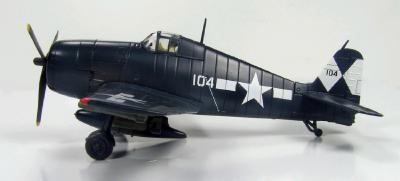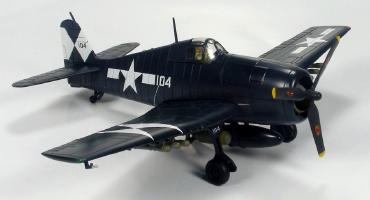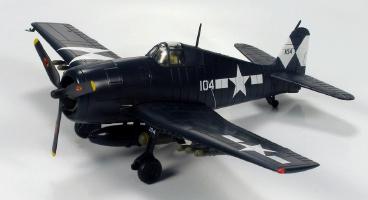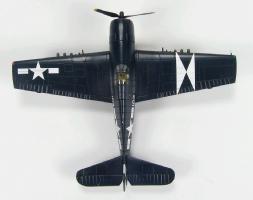Hobby Master Archive
Air Power Propellers 1/72
F6F
Air Powered Series F6F-5 VF-83 "104" USS Essex, 1945 limted edition 500
Engine: 2000hp Pratt & Whitney R-2800-10W Double Wasp 18-cylinder radial piston engine Weight: Empty 9150 lbs., Max Takeoff 15,410 lbs. Dimensions: Wing Span: 42ft. 10in. Length: 33ft. 7in. Height: 13ft. 6in. Performance: Maximum Speed at 23,500 ft: 380mph Cruising Speed at 6,000 ft: 168mph Ceiling: 37,300 ft Range: 1,530 miles with 150-gallon drop tank Armament: Six 12.7mm (0.5 inch) wing-mounted machine guns Two 1,000-lb bombs, or six 127mm (5-inch) rockets
July 1942 and was commissioned 31 December 1942. Together with AVG-83 she fought in or supported other groups. VF-83s greatest task was the assault on Okinawa where they had 122 confirmed kills. VF-83 was regularly charged with flying CAP mission for USS Essex CV-9 was the 4th United States vessel to bear the name. It was launched 31 protection of the Fleet. USS Essex was deactivated in late September 1945. This is a list of the actions USS Essex and VF-83 took part in: Marcus Island, Wake Island, Gilbert Islands, Tarawa, Kwajalein, Marshall Islands, Truk Island, Saipan, Tinian, Guam, Marcus Island, Wake Island, Palau Islands, Mindanao, Peleliu, Ryukyu, Okinawa, Formosa, Leyte Gulf, Philippine Islands, Mindoro, Lingayen Gulf, Iwo Jima, Japanese home islands.
In 1942-43 the F4U program was bogged down with delays and the USN needed a top notched carrier-based fighter. The Grumman F6F-5 was exactly what they were looking end of the war. In terms of size, the Hellcat was the second largest single engine fighter of the war, being just slightly smaller than the Republic P-47 “Thunderbolt”.
The Hellcat was more than up to the task of taking on the Japanese planes, it could fly about an average 55 mph faster than the Zero. When in combat at 20,000 feet it was 70 MPH faster while between 10,000 and 20,000 feet, it had a comparable rate of climb. Like so many other American fighters the F6F was heavier and more powerful than the Zero so if needed the pilot could nose over, apply max power and out dive his opponent before he became a statistic. F6Fs were credited with over three-quarters of the Navy’s air-to-air victories. The F6F Hellcat had the highest Kill/Loss ratio of any American fighter plane in Army, Navy, Marine or Air Force service during WWII. US Navy pilots affectionately referred to the Hellcat as the “Aluminum Tank”. With six wing mounted .50 caliber Browning M2 machine guns, 3 per wing and each with 400 rounds of ammunition, they could lay down 6 deadly strings of metal that few Japanese pilots would survive as their planes were ripped apart. The Hellcat could carry two 1,000 pound bombs with its most destructive weapons being six 5-inch HVAR’s (High Velocity Aircraft Rockets). With its armament, power, range (250 gallons capacity in internal tanks and a 150 gallon belly drop-tank) and assortment of weapons and equipment the Hellcat was able to carry out a wide array of missions: air to air combat, strike plane escort, combat air patrol, long range search, ground support, night fighting (F6F-5N), and photo recon (F6F-5P). When it was all over the F6F was one of the most feared and successful planes in WWII.
Hobby Master 1/72 Air Power Series HA1107 Grumman F6F-5, “104”, VF-83, USS Essex, 1945 Limited Edition 500 pieces only
Superb detailing in 1/72 scale. Pre-painted with pad applied markings. Fully assembled. Weapons that are not permanently attached. Display stand included. Option to display model with wheels up or down. Minimum use of plastic. Very collectable
THESE ARE PRE-PRODUCTION PICTURES AND NOT THE FINISHED PRODUCT.
| Added to archive | 2015-11-19 |
| Last modified | 2015-11-19 |





